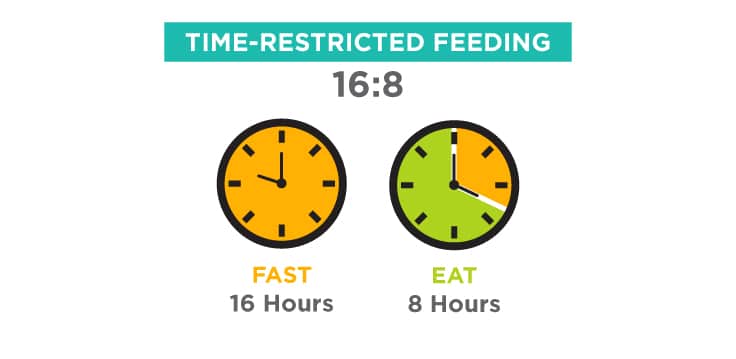I get commissions for purchases made through links on the site. As an Amazon and Clickbank Associate I earn from qualifying purchases. Learn more.
Imagine eating your favorite meal for dinner and not wanting to eat anything else…. Until lunchtime the next day.
Yes, you read that right- 16 hours of not eating anything, except plain water and calorie-free drinks. This may sound impossible, especially if you are used to eating snacks now and then, but you can do it. This is what we call intermittent fasting.
The first few days may seem challenging, but with time you will get used to it. If you want to stop overindulging unhealthy food and snacks in an effort to live healthily and lose excess weight, then this post is for you.
The good thing with intermittent fasting is that in addition to helping you lose those extra pounds, it allows your body to use food for the right purpose- powering you through the day and deriving the right nutrients from it.
Want to learn more about this pattern of eating? Well, we have prepared a detailed guide that covers everything you need to know about intermittent fasting- from its benefits to how it can help you induce ketosis if you are on a keto diet.
- The 28-Day Keto Challenge – The 28-Day Keto Challenge is a well-crafted plan that gets you through your first month. Simply follow this plan and you will succeed.
Keep reading to learn more.
Estimated reading time: 12 minutes
Table of contents
- What Exactly Is Intermittent Fasting?
- How Does Intermittent Fasting Work?
- What Makes Intermittent Fasting Great For Weight Loss?
- Further Explanation On How Fasting Induces Ketosis
- How to Practice Intermittent Fasting and Still Follow Keto Diet
- Benefits of Practicing Intermittent Fasting
- Intermittent Fasting for Mental Clarity
- FAQ about Intermittent Fasting
What Exactly Is Intermittent Fasting?
Often abbreviated as “IF,” Intermittent fasting can be termed as an eating pattern that involves timing your food intake to make the body burn fat for energy and pack lean muscles. It is important to mention that this is not a diet- rather, it is a pattern of eating.
To understand intermittent fasting, we first need to discuss two terms- feeding and fasting state. When you are taking your meals regularly (whenever you feel hungry), the body is said to be in a feeding state. However, when you are restricting yourself from eating food, even when hungry, the body is said to be in a fasting state.
As mentioned earlier, in intermittent fasting, you can eat virtually anything you want, but only during a given window.
Here are the main forms of intermittent fasting people follow;
1. Time-Restricted fasting
People following this fasting method restrict themselves from eating for several hours in a day, in most cases for 16 hours, and eat during the remaining 8 hours. Most people who follow this method fast at night and during the morning hours. This means eating their first meal at lunchtime and proceeding to eat for the next 8 hours before the next fast period begins.

2. Alternate Fasting
In alternate fasting, you switch between hours of eating healthy foods and hours of consuming zero-calorie beverages. You can follow your keto diet on the days when you are off from fasting.
The fasting period can last from 12 hours to 5 or 7 days. A popular method in alternate fasting is the Eat-Stop-Eat method, whereby you fast for 24 hours once or twice a week.
3. Modified Fasting
Commonly referred to as the 5:2 diet, modified fasting involves eating 25% of your daily recommended calories on two days every week (fasting days) and eating healthy foods during the other 5 days.
These three are the most common methods of intermittent fasting that people follow. Of the three, the most popular and most sustainable is time-restricted fasting. The other two might be too demanding for many people.
Let’s discuss how intermittent fasting promotes weight loss and healthy living.

How Does Intermittent Fasting Work?
For many people, the main aim of practicing intermittent fasting is to limit their calorie intake and force the body to optimize the available calories. This makes it great for people who tend to overindulge.
Once you start fasting, your body will adjust and start using the available calories from your meals. This explains why you will stop feeling overly hungry as you get used to fasting. The readjustment of the body helps it maintain the nutrient value of the food you consume.
During fasting, the body turns to fat for energy, and if this persists, it enters to ketosis state, and this speeds up weight loss. In the ketosis state, there is little or no glucose in the bloodstream, and thus it resorts to burning fat for energy.
In intermittent fasting, this is the same logic uses- after the body uses up all the calories and fats in the foods that we have eaten, it turns to stored fat during the fasting state for energy. This is the reason why people practicing intermittent fasting tend to lose weight at a faster rate.
What Makes Intermittent Fasting Great For Weight Loss?
One of the reasons intermittent fasting helps with weight loss is because it restricts one from overindulging. A diet such as 16:8, which restricts you from eating for 16 hours in a day, can help you avoid indulging in an unhealthy snack or energy drink. Overindulging unhealthy snacks is one of the main reasons people gain excessive weight.
And if, for some reason, you are unable to resist your appetite, you will still find it hard to overeat as your body will be getting used to optimizing the available calories and fats.
As long as you stick to your eating pattern, you will find it easier to lose excess weight. However, it is important to mention that at the start of your intermittent fasting, you may experience hunger pangs and irresistible cravings, but if you persevere, they will soon become a thing of the past as the body will start adjusting to burning stored fat and ketones for energy.
The main reasons for weight loss and improved health during intermittent fasting are increased ketone production and insulin reduction. When fasting, your insulin levels will decrease as there is little glucose in the bloodstream. This stimulates the body to release fat from body cells, thereby resulting in the production of ketones in a process called ketogenesis.
Further Explanation On How Fasting Induces Ketosis
When people are fasting or following the keto diet for weight loss, their main aim is to force the body to get into a ketosis state. And before discussing how to force the body into a ketosis state through fasting, it is important that we explain what ketosis is.
In basic terms, ketosis is the process of breaking down fat into a usable form of energy called ketones. This fat can be derived from the foods that we eat or from stored deposits in the body.
In other words, our bodies cannot use fat, in its whole form, as energy- fat has to be converted to ketones for the body to use it as energy.
Forcing the body to a ketosis state comes with plenty of benefits, including faster weight loss and better ability to overcome chronic illnesses.
To help you understand the benefits of fasting, let’s discuss how the body functions when you are on a regular carb diet.
As aforementioned, when your body has no glucose in the bloodstream, it turns to fat deposits for energy- the first source of energy is glycogen, while the 2nd is fat. If you are on a typical western diet (carb-centric diet), you will rarely get into a fasting state as glycogen will always be available.
This makes it hard for your body to get to a fat-burning mode- the reason many people struggle to burn excess fat deposits and lose weight. When in a feeding state, insulin levels will always be high, which means your body will always use glucose for energy- no time will it ever turn to fat for energy.
That’s why you are advised to cut your calorie intake (or food consumption) through fasting so as to reduce body dependence on glucose. Keep in mind that when glucose levels decline, our hunger hormones (Ghrelin and leptin) are triggered, and this makes us want to eat.
Ghrelin hormones trigger hunger feelings, which in turn increases your appetite. Leptin signifies satiety, and thus your hunger levels decrease when this hormone is released. A carb-centric diet triggers the release of Ghrelin while fasting balances these two hormones.
When fasting, your body turns to fat in a process similar to that of a keto diet. Fat cells are broken into fatty acids and ketones to cater for the ’emergency energy crisis,’ and if this period persists, your body enters the ketosis state.
Of course, people with medical conditions should consult their medical professionals for advice before practicing prolonged intermittent fasting periods, as it can take a toll on both your physical and mental state.
If you are to lose weight, you have to combine a low-calorie diet with intermittent fasting since the body will not have exhausted the calories and deposits you have just taken in a carb-centric meal. That’s why it is advisable that you combine the keto diet with intermittent fasting to increase the speed of getting to a ketosis state.
How to Practice Intermittent Fasting and Still Follow Keto Diet
It’s pretty simple- eat keto-friendly foods but only eat them within the eating window of your intermittent fasting.
Keep in mind that since the keto diet involves eating low-carb foods that are protein-rich, you may end up experiencing extreme hunger pangs that can be unbearable due to a lack of calories and nutrients.
That’s why you are advised to start with keto diet fast, then gradually incorporate intermittent fasting.
For instance, you can start by cutting out processed sugars and carbs in your ketogenic diet, then gradually cut on “healthier” carbs such as grains and fruits. After you have successfully managed to do this, you can now introduce intermittent fasting.
Once you manage to successfully incorporate intermittent fasting into your keto diet, you will begin to see great results in your weight loss journey.
- The Keto Box – The Keto Box offers 10+ Keto snacks that will be delivered to your doorstep every month. These monthly boxes are not customizable, but each one has different types of snacks specified for different months.
Let’s now talk about the benefits of intermittent fasting.
Benefits of Practicing Intermittent Fasting
Faster and healthier weight loss is not the only benefit of intermittent fasting. There are many more, including;
- Flushing toxins from your cells. Body cells tend to accumulate a lot of waste from food remains and junk foods, and this prevents them from functioning optimally. Intermittent fasting helps to clear out cellular waste making your body organs perform optimally
- Giving you better clarity and concentration– studies show that intermittent fasting can help one become more alert.
- May reduce risk of getting chronic diseases. Studies show that fasting appears to reduce the risk of cardiovascular disease and cancer
- Making life easier. We can all agree that fasting is easier than dieting. Studies prove that people adapt quickly to an intermittent fasting routine than dieting. Diet looks easy on paper but difficult to execute, especially over long periods. However, with intermittent fasting, you can easily follow a routine that works for you- say fasting from night to midday.
Other benefits include;
- Reduce insulin resistance, which can help protect against type 2 diabetes
- Can prolong your lifespan
- Reduces inflammation
Intermittent Fasting for Mental Clarity
In a world where mental acuity and cognitive performance are highly prized, intermittent fasting has emerged as a lifestyle choice that not only promotes physical health but can also provide a mental edge. The practice of intermittent fasting, which involves cycling between periods of eating and fasting, has garnered attention for its potential to enhance mental clarity, focus, and overall cognitive function.
The Science Behind It
Intermittent fasting triggers a cascade of biological processes within the body, some of which have a profound impact on the brain. Here’s a closer look at how intermittent fasting can promote mental clarity:
1. Enhanced Brain-Derived Neurotrophic Factor (BDNF): Intermittent fasting has been shown to increase the production of BDNF, a protein that supports the growth and maintenance of nerve cells. Higher levels of BDNF are associated with improved learning, memory, and cognitive function.
2. Improved Insulin Sensitivity: Fasting periods help regulate blood sugar levels and improve insulin sensitivity. Stable blood sugar levels are essential for maintaining mental focus and preventing the energy crashes often associated with high-carbohydrate meals.
3. Autophagy and Brain Health: Fasting triggers a process called autophagy, where the body cleans out damaged cells and regenerates new ones. This cellular “spring cleaning” extends to the brain, potentially reducing the risk of neurodegenerative diseases like Alzheimer’s.
4. Ketone Production: During fasting, the body shifts to burning fat for energy, producing ketones as a byproduct. Ketones are known to provide an efficient and steady source of fuel for the brain, which can enhance mental clarity and concentration.
5. Stress Resistance: Intermittent fasting may improve the brain’s resistance to stress through hormesis, a process where brief, controlled stressors make an organism more robust. This can lead to better resilience in challenging situations.
Practical Tips for Intermittent Fasting and Mental Clarity
To harness the mental clarity benefits of intermittent fasting, consider the following tips:
- Start Slowly: If you’re new to intermittent fasting, begin with a simple fasting schedule like the 16/8 method, where you fast for 16 hours and eat during an 8-hour window.
- Stay Hydrated: Drink plenty of water during fasting periods to support cognitive function and prevent dehydration.
- Prioritize Nutrition: When you do eat, focus on nutrient-dense foods that provide essential vitamins and minerals for brain health.
- Monitor Your Body: Pay attention to your body’s signals. If you feel overly fatigued or dizzy during a fast, it’s essential to listen to your body and adjust your fasting routine accordingly.
- Combine with Mindfulness: Incorporate mindfulness practices like meditation or deep breathing exercises to further enhance mental clarity during fasting periods.
Intermittent fasting can be a valuable tool for those seeking to optimize their mental clarity and cognitive performance. However, it’s essential to approach fasting with a balanced perspective, considering individual needs and consulting a healthcare professional if you have specific health concerns.
FAQ about Intermittent Fasting
Let’s now conclude our guide by answering the frequently asked questions.
No. This is a common myth that’s not true. Contrary, intermittent fasting can boost your metabolic rate, especially at the start.
Hunger tops the list of the side effects, but this may be bearable, especially for those already following a keto diet.
Constipation is another side effect since you are eating less. Unless it leads to bloating or abdominal discomfort, it shouldn’t scare you.
You may also experience headaches during the first few days of fasting. You can take some extra salt to moderate them.
Overall, many side effects are manageable and thus shouldn’t scare you.
Well, this depends on your fasts. When fasting, your body turns to fat for energy. However, prolonged fasting periods will mean your fat deposits will be exhausted, and thus your body will turn to amino acids for energy, and this will reduce muscle growth. It’s rare for the body to turn to muscles for fuel unless you get to starvation mode.
Yes. Drink a lot of water, tea, or coffee. Stay busy to avoid noticing hunger waves, and follow a low-carb diet to get faster results (weight loss).
Pregnant women, underweight people, lactating mothers, and anyone under 18 years. Also, those with underlying medical conditions should seek advice from their doctors before practicing intermittent fasting.



























